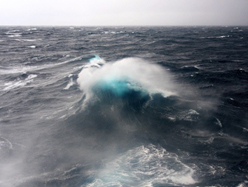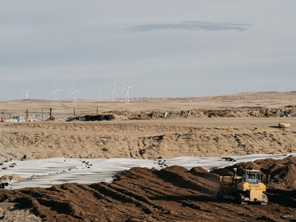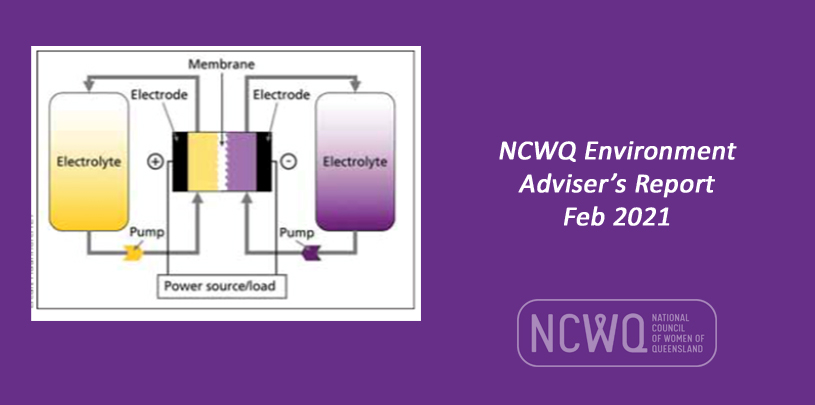By Pat Pepper, NCWQ Environmental Adviser
Renewable technology has advanced, helped by the support and funding from the Australian Renewable Energy Agency (ARENA). Security and reliability of supply has led to an interest in systems off the main electricity grids and in batteries. In this report, Wave, Hydrogen, Bioenergy and Waste Energy, and Hybrid systems are investigated as have Lithium-ion and Vanadium batteries. Although not renewable, Small (Nuclear) Modular Reactors (SMR) are also considered as a major push for renewables is reduction of emissions. The safe disposal or recycling of end-of-life products such as solar panels and wind turbine blades is discussed.
Australia is fortunate to be well supplied with many of the natural resources and essential minerals needed in the above systems. Which system is best suited depends on the situation. Australia can make a significant contribution to development and manufacture of renewables. However, further work is needed on how components at the end of their life will be recycled or otherwise deposed of in an environmentally safe manner.
Current situation with Australia’s electricity supply: When the cost of electricity rose by 35 % in real terms between 2007-8 and 2017-18, distributed energy resources (DER) such as rooftop solar boomed. Electricity demand peaks started to change and electricity was no longer a one-way flow. The increasing affordability and penetration of smart appliances, batteries, smart meters and other digital technologies changed consumer expectations. https://esb-post2025-market-design.aemc.gov.au/all-about-2025
The Energy Security Board (ESB) has published the 4th annual check-up on the Health of the National Electricity Market (NEM) which covers Queensland, New South Wales, Australian Capital Territory, Victoria, Tasmania and South Australia, as recommended by the Finkel Review. The assessment found that improvement had been made in generation capacity (reliability), emission reduction, competition and network investment. But system stability (security) and investor confidence remained critical. The ESB expressed concern about security constraints in some parts of the NEM and the increasing pressure on distribution networks from growing rooftop solar penetration. In the next three months, the ESB will focus on the following areas:
- Resource adequacy through the transition to lower emissions and new generation technologies.
- Essential system services and scheduling and ahead mechanisms –to keep the lights on as change happens.
- Demand side participation – unlocking opportunities for energy consumers to make the consumption choices that suit them best – such as investing in their own locally based generation
- Access and transmission – providing networks to meet future needs including connection of renewables, at the lowest possible cost.
Detailed designs for each of the reforms will be developed for further consultation in March, before final recommendations are made to energy ministers in mid 2021.
http://www.coagenergycouncil.gov.au/publications/2020-health-nem
https://esb-post2025-market-design.aemc.gov.au/directions-paper
The ESB has also published a consultation paper on Renewable Energy Zones (REZs) setting out options for how REZs could be implemented in the near term, addressing the questions of how to establish and maintain a REZ, and seeking input from stakeholders. Longer term options for transmission access and congestion management will be further considered http://www.coagenergycouncil.gov.au/reliability-and-security-measures/renewable-energy-zones
Renewable energy contributed 24 % to Australia’s total electricity generation in 2019.
Wind 8.5%,
Hydro 6.2%,
Small-scale solar 5.3%,
Large-scale solar 2.2%,
Bioenergy 1.4%,
Medium-scale solar 0.4%
Clean Energy Council. Clean Energy Australia Report 2020
The Australian Energy Market Operator (AEMO) estimates that NEM will need than 26 gigawatts (GW) of new variable renewables in the system as 63 per cent of coal-fired generation is set to retire by 2040. DERs, like rooftop PV, are expected to at least double by 2040. Likewise in Western Australia, rooftop PV is expected to double by 2030 from today’s installed capacity. https://aemo.com.au/newsroom/news-updates/aemo-welcomes-revised-inverter-standard
As more solar, wind and battery-stored energy, and less coal and gas are generated, emissions across the NEM, at present approximately 25 % lower than in 2005, are expected to be 40-60% lower by 2030 and 70-95% by 2042. https://www.aemc.gov.au/news-centre/media-releases/redesigning-energy-market-cant-wait.
Wave Energy is about to be harnessed and fed into the King Island’s fully-functional renewable energy microgrid which currently combines wind, solar and bio-diesel generation technology with battery storage. King Island is situated in the path of massive swells propelled by westerly ‘Roaring Forties’ winds blowing uninterrupted across the Indian and Southern Oceans. Melbourne based company, Wave Swell Energy, has designed and constructed the 200 KW Uniwave device to be partially submerged in shallow waters off King Island’s coast. Wave Swell Energy CEO, Dr Tom Denniss explains the Uniwave 200 will use “oscillating water column” technology to push air into a chamber fitted with an electricity-generating turbine, functioning like an artificial blowhole, using changes in air pressure to spin the turbine as waves force their way through an opening on one side of the device. Having no moving parts in or below the water line, ensures ease of access, minimises the cost of operation and maintenance, and precludes any detrimental effects on marine life. https://arena.gov.au/blog/king-island-wave-power/ ; https://arena.gov.au/projects/king-island-renewable-energy-integration-project/; https://wholesaleinvestor.com.au/wave-swell-energys-update-on-its-king-island-wave-energy-generator/

CSIRO research has shown wave energy could contribute up to 11% of Australia’s energy (enough to power a city the size of Melbourne) by 2050, making it a strong contender in Australia’s renewable energy mix. Strong Southern Ocean winds generate consistently large waves which travel northwards to Australia’s southern coastline, providing ideal conditions for wave energy production. https://www.csiro.au/en/Research/OandA/Areas/Marine-technologies/Ocean-energy/Wave-energy
Wind/Solar Hybrid systems: Other off the grid sites have followed King Island’s lead and installed hybrid control systems, along with enabling technology to better manage the variable renewable generation and reduce diesel fuel consumption .e.g.
- On Rottnest Island, the hybrid control system coordinates the generation (wind, solar and low load diesel) with enabling technologies, including a dynamic resistor and demand management of the desalination plant. The resistor solved the problem of fast fluctuations in power created by wind turbines. By integrating renewable resources with the island’s desalination plant and water storage facilities, when there is surplus renewable energy it is used to create clean drinking water. https://arena.gov.au/blog/off-the-grid-independence-for-rottnest-island/
- Completed in 2020, the Agnew Hybrid Renewable Microgrid (Australia’s largest hybrid renewable energy microgrid) is comprised of four key components managed by an advanced control system: five 110m wind turbines, each with a rotor diameter of 140m, delivering 18MW, a 10,710-panel solar farm generating 4MW, a 13MW/4MWh battery system and an off-grid 21MW gas/diesel engine power plant. In favourable weather conditions, the power station has delivered up to 85% of the mine’s power requirements with renewable energy. https://edlenergy.com/wp-content/uploads/2021/01/EDL-Fact-Sheet-Agnew-Hybrid-Renewable-Microgrid-1.pdf
Hydrogen: Western Australian gas distributor ATCO has built a Clean Energy Innovation Hub at its headquarters in Perth producing hydrogen from solar panels on site to blend with natural gas and test in domestic appliances. Existing home appliances can handle around 13% of hydrogen so it is expected the existing gas grid could be safely converted to handle 10% hydrogen using current technology. https://arena.gov.au/blog/australias-renewable-hydrogen-industry-prepares-for-take-off/
Hydrogen hybrid power station system: Horizon Power is planning to build Australia’s first remote microgrid using renewable hydrogen generation in Denham, Western Australia. 704 kW of solar will power an electrolyser to produce hydrogen for storage which can later be used in the fuel cell to deliver electricity when it is needed. https://arena.gov.au/news/powering-regional-and-remote-australia-with-renewable-hydrogen/
Bioenergy and Energy from Waste: With the Logan City Biosolids Gasification Project: Biosolids (treated and partially dewatered sewage sludge) from Loganholme Wastewater Treatment are dewatered in a centrifuge, dried in a paddle dryer, and treated at high temperatures before being processed by a gasifier to produce a biochar containing carbon, phosphorus and potassium that could be used as an environmentally friendly soil conditioner. Gas produced during the process is to be utilised within the system as part of the biosolid drying process. An onsite solar power system will also help to support the facility to be almost entirely renewable and energy neutral. The facility is expected to be fully operational by July 2021. https://arena.gov.au/news/wastewater-treatment-plant-to-use-gasification-for-waste-disposal
Batteries: One of the biggest criticisms of renewable energy has been that the output of wind and solar farms can vary with the weather and time of day. Battery storage is increasingly being used in microgrids and the national electricity grid (at both the transmission and distribution levels) as it can respond faster than other energy storage or generation technologies, and help maintain grid stability by turning on and off in fractions of a second.
Lithium-ion is the most common battery chemistry used to store electricity. https://arena.gov.au/renewable-energy/battery-storage/
The world lithium resources in 2017 are estimated to be 15 700 kt:-
Chile 7500 kt, (48% of world resources)
China 3200 kt (20%)
Australia 2803 kt (18%)
Argentina 2000 kt (13%)
Other countries (Portugal, Brazil, USA, Zimbabwe) each < 1%.
The resource data do not, however, include Canada. Australia was the world’s largest producer, 21.3 kt for 47% of world production. Champion, D., 2019. Australian Resource Reviews: Lithium 2018. Geoscience Australia, Canberra.
Lithium-ion battery manufacturers are primarily based in Japan and China.
However, Energy Renaissance, Australia’s first lithium-ion battery manufacturer, is building Renaissance One, a new A$28 million battery manufacturing facility in Tomago. When operating at capacity, it is expected to be able to provide enough batteries to power every public school, hospital, fire station, SES unit and new home built in Australia. More than half of the batteries produced are expected to be exported through the Port of Newcastle. https://www.energymagazine.com.au/go-ahead-for-australias-first-lithium-ion-battery-manufacturing-facility/ Oct 13, 2020
Hornsdale Power Reserve in South Australia has recently been expanded to 150 MW and 193.5 MWh of capacity and is now the world’s largest lithium-ion battery. Research by engineering consultants Aurecon showed the battery had already delivered $150 million in savings for South Australian energy consumers, as well as creating 158 jobs and more than $300 million in economic benefits for the state. https://arena.gov.au/blog/south-australian-battery-grows-bigger-and-better/
Edify Energy have installed at grid scale 25 MW / 50 MWh lithium-ion battery alongside their solar farm at Gannawarra in northern Victoria. It will power 16,000 homes for two hours in the event of a major outage and provide services to help to maintain a stable network frequency, which in turn boosts the system strength of the local grid. https://arena.gov.au/blog/storing-renewable-energy-in-the-worlds-biggest-batteries/
It is important to be vigilant in ensuring the environment is safeguarded. Serious environmental issues with lithium mines polluting rivers and killing fish and other livestock have been reported e.g. Ganzizhou Rongda lithium mine in Tibet. In Chile, a mayor issue is the water consumption associated with lithium mining. For every tonne of lithium produced, 500,000 gallons of water is used. In Salar de Atacama, mining activities consumed up to 65% of the region’s water, causing havoc for local farmers.
Recycling the waste is also a problem. Fluids from the batteries could leak into landfills and be released into the environment. Research in Australia found that just 2% of the country’s 3,300 tonnes of lithium-ion waste is recycled. https://www.nsenergybusiness.com/features/lithium-ion-battery-environmental-impact/
Cobalt is an essential mineral for the lithium-ion batteries. It offers the highest energy density and is key for boosting battery life.
Democratic Republic of the Congo is the largest supplier of cobalt producing around 70% of the world’s cobalt. Roughly 20% of Congolese cobalt comes from artisanal mining which is often carried out by hand, using basic equipment in dangerous working conditions. Frequent fatal accidents in unsafe tunnels and prevalent child labour have been reported.
To combat violation of environmental and human rights standards, several companies within the industry are supporting cobalt blockchain technologies, which use a method of chemical “fingerprinting” to track down where cobalt has come from. However, while end user companies such as electric vehicle, smartphones and laptop manufacturers wish to use cobalt produced ethically, there’s only a limited number of battery factories in the world that can produce products in certain ways and cobalt from all over the world tends to be batched together making it to be difficult to apply tracing right down the supply chain. The Congolese government is endeavouring to develop artisanal mining standards, identifying parameters and means of evaluation to ensure the consistent enforcement of these standards.
China’s refineries, fed in large part by feedstuff from Chinese owned mines, supply 80% of the world’s battery-ready high-grade cobalt.
Australia produces roughly 4000 tonnes of cobalt per annum – around 3% of global production – despite possessing over 16% of the world’s cobalt resource.
Cobalt Blue’s Broken Hill cobalt project in New South Wales, designed to operate as both a cobalt mine and a refinery that produces battery-ready cobalt sulphate is a collaborative 3 year partnership with the Australian Government’s Future Battery Industries Project and major domestic lithium, nickel and manganese producers to assess whether Broken Hill cobalt can supply a future Australian battery industry. https://www.cobaltblueholdings.com/australias-opportunity-in-the-global-cobalt-industry-featuring-cobalt-blue; AUSTRALIANMINING 44 JUNE 2020; https://theconversation.com/as-cobalt-demand-booms-companies-must-do-more-to-protect-congolese-miners-149486; https://www.nsenergybusiness.com/features/lithium-ion-battery-environmental-impact/
Vanadium Redox Flow Batteries(VRB): Energy is stored in an electrolyte solution containing the element vanadium, which commonly exists as ions with different charges and does not lose efficiency over time. This allows the flow battery to reliably charge and discharge indefinitely in contrast to a lithium-ion battery, which relies on repeated chemical reactions that cause degradation over time and eventually lead to performance losses. https://arena.gov.au/blog/south-australia-goes-with-the-flow-battery/.
 The main advantages of VRBs are that they offer almost unlimited capacity simply by using sequentially larger storage tanks, can be left completely discharged for long periods of time with no ill effects, can be recharged by replacing the electrolyte if no power source is available to charge it, and suffer no permanent damage if the electrolytes are accidentally mixed. The electrochemistry of the transition element Vanadium and the evolving design of VRBs offers a path to large scale energy storage units.
The main advantages of VRBs are that they offer almost unlimited capacity simply by using sequentially larger storage tanks, can be left completely discharged for long periods of time with no ill effects, can be recharged by replacing the electrolyte if no power source is available to charge it, and suffer no permanent damage if the electrolytes are accidentally mixed. The electrochemistry of the transition element Vanadium and the evolving design of VRBs offers a path to large scale energy storage units.
The first major (800MWh) VRB storage plant is under construction in Dalian, China. https://www.energy-storage.news/blogs/redox-flow-batteries-for-renewable-energy-storage; https://www.labnews.co.uk/article/2030898/go-with-the-flow-transition-to-vanadium-batteries-is-gathering-pace
At a site near Neuroodla, approximately 430km north of Adelaide, a project led by Yadlamalka Energy with hardware from flow battery specialists, Invinity Energy System, is building a system with a battery (2 MW / 8 MWh of capacity) charged by a 6 MW solar array. It will be connected to the NEM, providing energy to the wholesale market and frequency control ancillary services. The project will have the ability to provide vital support for the electricity grid in South Australia, which relies heavily on intermittent renewable energy sources, and also shift renewable energy generation into more valuable evening peak pricing periods, improving competitiveness in the market.
The liquid vanadium solution is estimated to last the 25 year life of the battery and can then be reused in other energy storage or metallurgical applications. The remainder of the battery made from common materials like steel, polyethylene and rubber can be disposed of through common municipal recycling at the end of the battery’s life. https://arena.gov.au/blog/south-australia-goes-with-the-flow-battery/
Nearly all of the world’s vanadium is derived from mineral concentrates (typically vanadium-rich and titanium-rich magnetite) separated from mined ore, or as a by-product of steel-making slags.
China dominates world vanadium resources with 42%, followed by Russia at 23%, and Australia at 18%. However, because vanadium can be recovered as a by-product or a co-product of steel slags, the estimated world resources are not fully indicative of available supply.https://minerals.usgs.gov/minerals/pubs/commodity/vanadium/index.html#mcs
Bibliographical reference: Summerfield, D., 2019. Australian Resource Reviews: Vanadium 2018. Geoscience Australia, Canberra. http://dx.doi.org/10.11636/9781925848274 Should VRBs be a contender in Australia’s renewable energy mix?
Solar: Australia has more than 2.3 million rooftop solar power systems installed across the country with panels which have a life of 15 to 25 years. A typical crystalline silicon PV module contains glass, polymer, aluminium, silicon, copper and small amounts of silver, tin, lead, and other metals and components. Australia does not regulate recycling of end-of-life PV modules unlike the EU which mandates European countries to adopt PV waste management programs. Producers there are responsible for the take-back and recycling of the panels they sell.
While the cost of recycling is higher than landfill, and the value of recovered materials is smaller than the original, most PV waste will end up in landfill. If lead and tin is leached into soil and groundwater, there could be health and environmental problems. Currently the aluminium frames and the terminal boxes (20% of panel weight) are recycled.
However there are other possibilities:-
- solar-grade silicon from PV waste could be recovered for second-use applications in solar panels or repurposed for value-added application in the anode of the 3b generation of Lithium-ion batteries. for electric car batteries,
- copper and silver could be recovered.
Two Australian facilities offering PV recycling, Reclaim PV and Ecoactiv offer pickup services in most areas of Australia, and are continuing to expand their collection abilities, and increase their recycling capabilities. https://www.provenenergy.com.au/solar-recycling/ August 31, 2020
The Australian continent has the highest solar radiation per square metre of any continent and consequently some of the best solar energy resource in the world. The regions with the highest solar radiation are the desert regions in the northwest and centre of the continent. http://www.ga.gov.au/scientific-topics/energy/resources/other-renewable-energy-resources/solar-energy. With appropriate legislation and further research and development, could Australia have a thriving PV manufacture and recycling industry?

Wind: On average, wind turbines last about 25 years. Wind power is carbon-free and about 85% of turbine components, including steel, copper wire, electronics and gearing can be recycled or reused. But the fiberglass blades built to withstand hurricane-force winds, can’t easily be crushed, recycled or repurposed. American Wind Energy Association in Washington claims landfill is safest and cheapest.
https://www.bloomberg.com/news/features/2020-02-05/wind-turbine-blades-can-t-be-recycled-so-they-re-piling-up-in-landfills; https://blog.ucsusa.org/james-gignac/wind-turbine-blades-recycling
However, a consortium of French research institutions, wind turbine designers and manufacturers and utilities giants Engie and Suez, ZEBRA (Zero wastE Blade ReseArch) aims to develop and manufacture the first 100% recyclable thermoplastic wind turbine blades. This includes developing new resins and composite materials that reduce the amount of resources required in the production of blades, while also allowing the materials to be recycled when wind turbines are decommissioned. https://reneweconomy.com.au/french-consortium-developing-first-completely-recyclable-wind-turbine-blades-31940/ Australia has some of the best wind resources in the world. These are located mainly in the southern parts of the continent (which lie in the path of the westerly wind flow known as the ‘roaring 40s’) and reach a maximum around Bass Strait. http://www.ga.gov.au/scientific-topics/energy/resources/other-renewable-energy-resources/wind-energy
Small modular nuclear reactors: While not renewable, these units (SMRs) address a major reason behind renewables – cutting carbon emissions. A desire to reduce the impact of capital costs and to provide power away from large grid systems has driven interest in SMRs. There are a number of advantages:
- modular allowing SMR to be used as a single unit or in combination with other units which can be brought online incrementally for greater power output. Designed to “plug in” to existing power networks, so they can essentially replace an aging power.
- a high level of passive or inherent safety features to cater for any malfunction and which may provide more protection from natural (g.seismic or tsunami according to the location) or man-made (e.g. aircraft impact) hazards. Also the emergency planning zone required is designed to be no more than about 300 m radius.
- produced largely in factories providing short construction times and reduced siting costs.
- use only a small amount of fuel and refuel approximately every two years.
- compatible with the existing electricity grid so their operation would be expected to enhance reliability of the grid and secure supply, especially when renewables are part of the energy mix.
- easier to cool during operation and after shutdown.
- zero-emissions.
https://www.ansto.gov.au/news/what-are-small-modular-reactors-and-what-makes-them-different Published on the 17th July 2020 by ANSTO Staff
https://www.world-nuclear.org/information-library/nuclear-fuel-cycle/nuclear-power-reactors/small-nuclear-power-reactors.aspx (Updated December 2020)
Australia accounted for 12 per cent of world uranium production in 2018–19 (7,618 tonnes), and is the world’s third largest producer.
Department of Industry, Science, Energy and Resources (2020), Australian Energy Update 2020, Australian Energy Statistics, September, Canberra. Could SMRs be a contender in Australia’s energy mix?
The National Council of Women of Queensland Inc (NCWQ) is a non-party-political, non-sectarian, not-for-profit, umbrella organisation with broadly humanitarian and educational objectives. It seeks to raise the awareness of members as to their rights and responsibilities as citizens and encourages their participation in all aspects of community life.
The NCWQ website content manager (webmaster) posts content on behalf of the NCWQ Management Committee and its members. If you have important communications, an event of matters of interest you would like to share with NCWQ, its members, network and supporters, please contact us with details. Thank you.



